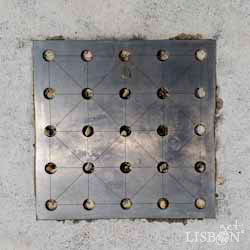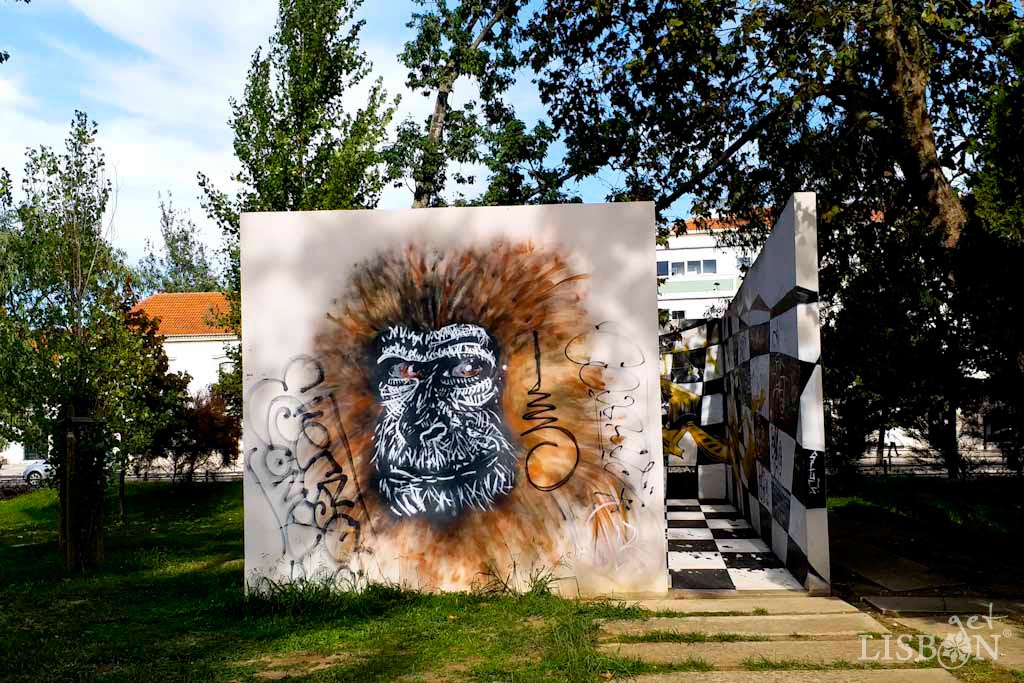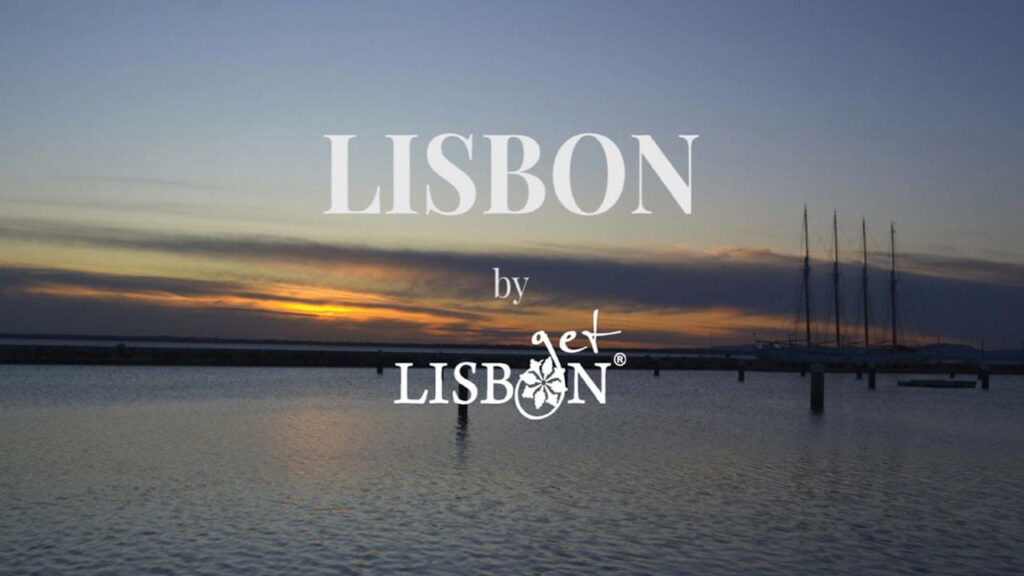Original article published on 21 October 2020
Did you know there’s mathematics in Campo Grande Garden? References that bring us to this science are spread across this entire area, but few know of its existence.
During our search about the public art of Campo Grande Garden we noticed, among others, board games, playground and historic marks related to maths, which caught our attention…
Games and References Related to Mathematics in Campo Grande Garden
This initiative to evoke the mathematical knowledge resulted in the collaboration between the Portuguese Mathematical Society and the City Council of Lisbon, at the time of the requalification of the Campo Grande Garden between 2013 and 2018.
Let’s find out what and where they are… by starting our route in the north zone of the Garden.
Board Games in Garden Benches

At the back of the Caleidoscópio Building there are four benches with eight boards from four different games.
The rules are explained in the plaque next to each board, where there’s also a short description about the history of the respective games:

Alquerque: “… it can be considered a former version of the game Draughts. It’s a very old game with written references that date back to the 10th century. The first set of rules, even though not completely specified, emerged in the 13th century in the “Livro de Jogos” (“Book of Games”) of the King Afonso [of Castile], the Wise.”

Hex: “… it was independently invented by two mathematicians: the Danish Piet Hein in 1942 and the American (winner of the Nobel Prize in Economic Sciences) John Nash in 1948. The game has strong connections to a few well-known mathematical theorems. It can also be mathematically proved that there can’t be ties in this game.”

Mancala: “The games, generically designated by Mancala, are a set of approximately 200 different games, among them the well-known Ouri. This family of games is really old and its origin is uncertain, possibly African.”
![Board game Nine men’s morris: it was really popular in medieval Europe, but there are much older references, such as in “The Art of Love” by Ovid [(43 BC - 17 oru 18 AD)]. This game is an ancestor of the Noughts and Crosses game.](https://getlisbon.com/wp-content/uploads/2020/10/02d-board-game-nine-mens-morris-mathematics-campo-grande-garden-getlisbon.jpg)
Nine men’s morris: “… is a very old game. It was really popular in medieval Europe, but there are much older references, such as in “The Art of Love” by Ovid [(43 BC – 17 oru 18 AD)]. This game is an ancestor of the Noughts and Crosses game.”
To play these games you simply need to gather on the floor the necessary stones. 🙂
They evoke the centenarian tradition of board games in the daily life of the Lisbon locals. The many boards engraved in stone that can be found in the historic areas of the city are proof of that.
Ames Room

The following reference to mathematics in Campo Grande Garden is called Ames Room. It is located on the east side, in the same direction of the Casa do Lago.
The Ames Room was created in 1946 by Adelbert Ames, Jr., a North American ophthalmologist that based himself on theories developed by the German doctor, mathematician and physicist Hermann von Helmholtz.
Its purpose is for the observer to experience optical illusions. In this case the observer takes a look from the outside to the inside through a small hole that is on the wall on the right side.
At the same time, two people must enter and stand one on the left corner and one on the right corner of the wall opposite to the observer. The result is a sensation of a big discrepancy of size between the two people.
In truth, the structure of this Room isn’t as regular as it seems. If we observe it with attention, we notice that it has a trapezoidal shape with a checkered and sloped floor, characteristics that contribute to the optical illusion.
However, a lack of civility unfortunately left this Room vandalised and with no hygienic conditions for people to have this interesting experience.


The Seven Bridges of Königsberg

We’re now moving to the south side of the Garden. Over the lake we can find a set of wooden bridges that at first glance may seem just a playful structure.
But it is a well-known mathematical problem called “The Seven Bridges of Könisberg”. This city of the former Prussia had a peculiar characteristic, the existence of seven bridges that connected four parcels of land.
One day a mathematical problem emerged: would it be possible to leave a starting point and return to it, by crossing all the seven bridges, but without crossing each more than once?
It was the mathematician Leonhard Euler that in 1736 reached the conclusion that there was no solution. From this study originated the graph theory, a branch of mathematics that studies the relations between objects.
Euler to address the Königsberg problem, used a simplified representation scheme:

After taking an attentive look we realised that the Seven Bridges of Königsberg of Campo Grande Garden are a fusion of the initial scheme with the simplified version of Euler.
It conjugates the green spaces around the lake (ground) with the wooden bridges and its intersections (the lines and dots of the simplified scheme), resulting in a creative solution that is well integrated in the space. ☺
Poliedric Playground Climbing Net

It’s also possible to find the presence of mathematical knowledge in a climbing net for children.
This quadrangular pyramid, i.e. polyhedron, refers to geometry, a branch of mathematics that studies issues related to shape, size, relative position between figures or properties of space.
Loxodrome of Pedro Nunes

Continuing on southwards, a large metal sphere appears before us. It is a representation of the Loxodrome of Pedro Nunes, a Portuguese mathematician of the 16th century, a time when mathematical knowledge was crucial for the navigators.
Pedro Nunes found that a ship on a constant course that crosses all meridians of longitude at the same angle, makes up a spiral line. He called it the Rhumb Line, which later became known as Loxodrome.
With this piece we’ve reached the extreme south but the references to mathematics in Campo Grande Garden are not over yet.
| Never miss another article | Subscribe here |
Historical Landmarks of Mathematics

Along the pavement on the west side all the way to the northern top of the Garden, about 100 metal plates that record historical landmarks of mathematics can be observed on the ground.
The first one goes back to the 20th century BC and in the plate we can read: “In Babylon, a sexagesimal system is used”. The last one refers to 2007 with the landmark: “A team of researchers in North America and Europe describe a gigantic structure known as E8 using computer networks”.
We’ve reached the end of this peculiar route about mathematics in Campo Grande Garden that in a fun way reminded us about the constant presence of this science around us.
We hope to have given you a good grasp of everything, as some of these references lack an explanation.
Curious fact
On the west side of the Brazilian city of Rio de Janeiro there is a populous neighborhood called Campo Grande, an area of large orange production in the first half of the 20th century.
In this neighbourhood several monuments were put up to mark this important period in its history. One of which is a sphere made up of an orange spiral band that represents the orange peel when it’s cut.
A curious coincidence with the representation of the Loxodrome of Pedro Nunes in Lisbon, in a place also called Campo Grande, which in turn is crossed by Brasil Avenue, but that is over 7000km away. 😉

The project getLISBON has been very rewarding and we want to continue revealing the singularities of fascinating Lisbon.
Help us keep this project alive!
By using these links to make your reservations you’ll be supporting us. With no extra costs!
• Looking for a different experience? We can create a customised itinerary based on your interests. Contact us!
• Or if you prefer tours and other activities in various destinations, take a look at GetYourGuide.
• Save time and money with a flexible Lisbon Card!




